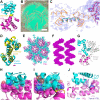This is a preprint.
Fusion crystallization reveals the behavior of both the 1TEL crystallization chaperone and the TNK1 UBA domain
- PMID: 37398013
- PMCID: PMC10312729
- DOI: 10.1101/2023.06.14.544429
Fusion crystallization reveals the behavior of both the 1TEL crystallization chaperone and the TNK1 UBA domain
Update in
-
Fusion crystallization reveals the behavior of both the 1TEL crystallization chaperone and the TNK1 UBA domain.Structure. 2023 Dec 7;31(12):1589-1603.e6. doi: 10.1016/j.str.2023.09.001. Epub 2023 Sep 29. Structure. 2023. PMID: 37776857 Free PMC article.
Abstract
Human thirty-eight-negative kinase-1 (TNK1) is implicated in cancer progression. The TNK1-UBA domain binds polyubiquitin and plays a regulatory role in TNK1 activity and stability. Sequence analysis suggests an unusual architecture for the TNK1 UBA domain, but an experimentally-validated molecular structure is undetermined. To gain insight into TNK1 regulation, we fused the UBA domain to the 1TEL crystallization chaperone and obtained crystals diffracting as far as 1.53 Å. A 1TEL search model enabled solution of the X-ray phases. GG and GSGG linkers allowed the UBA to reproducibly find a productive binding mode against its host 1TEL polymer and to crystallize at protein concentrations as low as 0.1 mg/mL. Our studies support a mechanism of TELSAM fusion crystallization and show that TELSAM fusion crystals require fewer crystal contacts than traditional protein crystals. Modeling and experimental validation suggest the UBA domain may be selective for both the length and linkages of polyubiquitin chains.
Conflict of interest statement
Declaration of interests
The authors declare no competing interests.
Figures






Similar articles
-
Fusion crystallization reveals the behavior of both the 1TEL crystallization chaperone and the TNK1 UBA domain.Structure. 2023 Dec 7;31(12):1589-1603.e6. doi: 10.1016/j.str.2023.09.001. Epub 2023 Sep 29. Structure. 2023. PMID: 37776857 Free PMC article.
-
Crystals of TELSAM-target protein fusions that exhibit minimal crystal contacts and lack direct inter-TELSAM contacts.Open Biol. 2022 Mar;12(3):210271. doi: 10.1098/rsob.210271. Epub 2022 Mar 2. Open Biol. 2022. PMID: 35232248 Free PMC article.
-
Increasing the bulk of the 1TEL-target linker and retaining the 10×His tag in a 1TEL-CMG2-vWa construct improves crystal order and diffraction limits.Acta Crystallogr D Struct Biol. 2023 Oct 1;79(Pt 10):925-943. doi: 10.1107/S2059798323007246. Epub 2023 Sep 25. Acta Crystallogr D Struct Biol. 2023. PMID: 37747038 Free PMC article.
-
Structural and functional studies of mutations affecting the UBA domain of SQSTM1 (p62) which cause Paget's disease of bone.Biochem Soc Trans. 2004 Nov;32(Pt 5):728-30. doi: 10.1042/BST0320728. Biochem Soc Trans. 2004. PMID: 15493999 Review.
-
Tnk1/Kos1: a novel tumor suppressor.Trans Am Clin Climatol Assoc. 2010;121:281-92; discussion 292-3. Trans Am Clin Climatol Assoc. 2010. PMID: 20697568 Free PMC article. Review.
References
-
- Hoehn G.T., Stokland T. , Amin S., Ramírez M., Hawkins A.L., Griffin C.A., Small D. and Civin C.I. (1996). Tnk1: A Novel Intracellular Tyrosine Kinase Gene Isolated from Human Umbilical Cord Blood CD34+/Lin-/CD38-Stem/Progenitor Cells. Oncogene 12, 903–913. https://europepmc.org/article/med/8632913. - PubMed
-
- Henderson M.C., Gonzales I.M., Arora S., Choudhary A., Trent J.M., Von Hoff D.D., Mousses S. and Azorsa D.O. (2011). High-throughput RNAi Screening Identifies a Role for TNK1 in Growth and Survival of Pancreatic Cancer Cells Molecular cancer research 9, 724–732. 10.1158/1541-7786.MCR-10-0436. - DOI - PMC - PubMed
Publication types
Grants and funding
LinkOut - more resources
Full Text Sources
